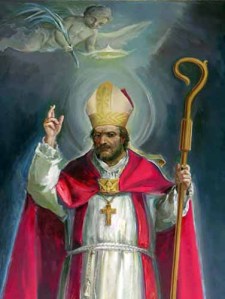St. Probus Bishop of Ravenna
November 10
Roman Martyrology: At Ravenna, St. Probus, Bishop, in whose honor the Bishop St. Maximus the famous basilica dedicated Class.
Probe: a bell’aggettivo, used at least once, even as a name, in the way they are used even today the names of Modesto, Pius, Clement, and Benedict Benigno. Probus means honest, upright, honest: Even today, for every profession, there are the so-called viri honest, that honest men, who judge the correctness of my colleagues in professional life.
The literature records a famous grammarian, Marcus Valerius Probus. Policy, a Roman emperor, Marcus Aurelius Probus, under which the Christians, at least officially, were not persecuted. And Christians should cherish that name that promises fairness and honesty, even in women who took the name of Probus.
Thus, the Christian calendar records a Proba Holy Virgin and Martyr, April 28, another Santa Proba, also Virgin and Martyr, 30 April. Among the Saints Probe is a venerable Bishop of Verona, the fourth century, January 12, a bishop of Rieti mentioned in the Dialogues of St. Gregory the Great, March 15.
On April 5, the couple are remembered even exemplary Christians in the name, Probus and Grace. Finally, today is the feast of St. Probus, Bishop of Ravenna, or better than Class as a class, the military port of Ravenna, came the early Christians, who had the first cemetery in which buried Apollinaris, sent by St. Peter, According to tradition, to evangelize the Adriatic coast.
The tomb of the first bishop of Ravenna was built then the basilica of St Apollinaris in Classe, splendid mosaics which still arouse admiration surprised. And great the images in the mosaics of the immediate suc-mold of Sant’Apollinare: Ecclesia, Severo, Bear and Ursicinus. If the series had been continued after the bears would come lambs. And it is the Bishop Lamb, of the IX century, speaking of the apostolic tradition of Ravenna, mentions two bishops named Probus. The first was the seventh of the series, the second the fourteenth.
“The holy soul of Probus – says the Bishop Lamb – November 10 left his body.
And behind the statement of Bishop Lamb, that historical criticism can neither confirm nor deny, is remembered today that Bishop, in name and upright life, and so holy as probity and sanctity are mixed in the figures of shepherds were an example of fairness and virtue to the whole flock entrusted to their care.
Source: Parish Archives
Source: Santi e Beati



 Posted by naniam
Posted by naniam 








